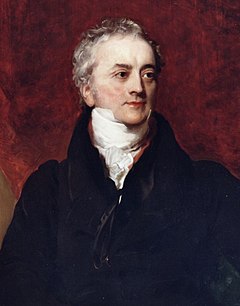
Back Thomas Young Afrikaans توماس يانغ (عالم) Arabic توماس يونج ARZ Thomas Young AST توماس یانق AZB Томас Юнг Byelorussian Томас Юнг BE-X-OLD Томас Йънг Bulgarian থমাস ইয়ং Bengali/Bangla Thomas Young BS
Thomas Young | |
|---|---|
 Portrait by Henry Perronet Briggs, 1822 | |
| Born | 13 June 1773 Milverton, Somerset, England |
| Died | 10 May 1829 (aged 55) London, England |
| Alma mater | University of Edinburgh Medical School University of Göttingen Emmanuel College, Cambridge |
| Known for | Wave theory of light Double-slit experiment Astigmatism Young–Dupré equation Young–Helmholtz theory Young–Laplace equation Young temperament Young's Modulus Young's rule |
| Scientific career | |
| Fields | Physics Physiology Egyptology |
| Signature | |
Thomas Young FRS (13 June 1773 – 10 May 1829) was a British polymath who made notable contributions to the fields of vision, light, solid mechanics, energy, physiology, language, musical harmony, and Egyptology. He was instrumental in the decipherment of Egyptian hieroglyphs, specifically the Rosetta Stone.
Young has been described as "The Last Man Who Knew Everything".[1] His work influenced that of William Herschel, Hermann von Helmholtz, James Clerk Maxwell, and Albert Einstein. Young is credited with establishing Christiaan Huygens' wave theory of light, in contrast to the corpuscular theory of Isaac Newton.[2] Young's work was subsequently supported by the work of Augustin-Jean Fresnel.[3]
- ^ Cite error: The named reference
:0was invoked but never defined (see the help page). - ^ Kipnis, Naum S. (1991). History of the Principle of Interference of Light. Springer. p. 65. ISBN 9780817623166.
- ^ Nolte, David D. (2023). Interference: The History of Optical Interferometry and the Scientists Who Tamed Light (Oxford University Press, 2023). Oxford University Press. ISBN 978-0192869760.pp. 45-84
© MMXXIII Rich X Search. We shall prevail. All rights reserved. Rich X Search